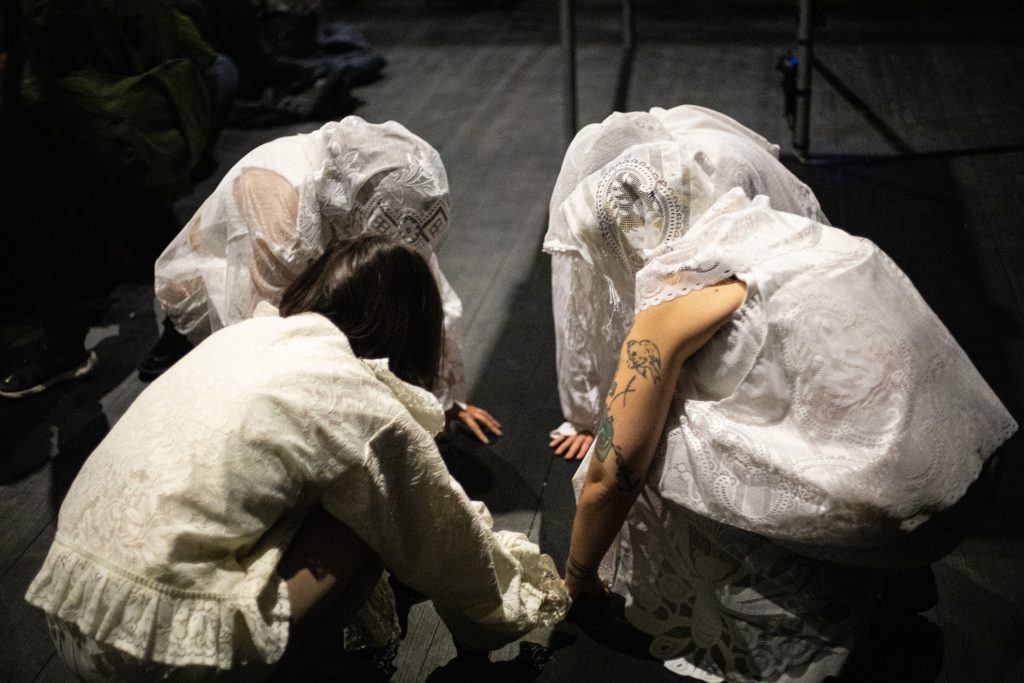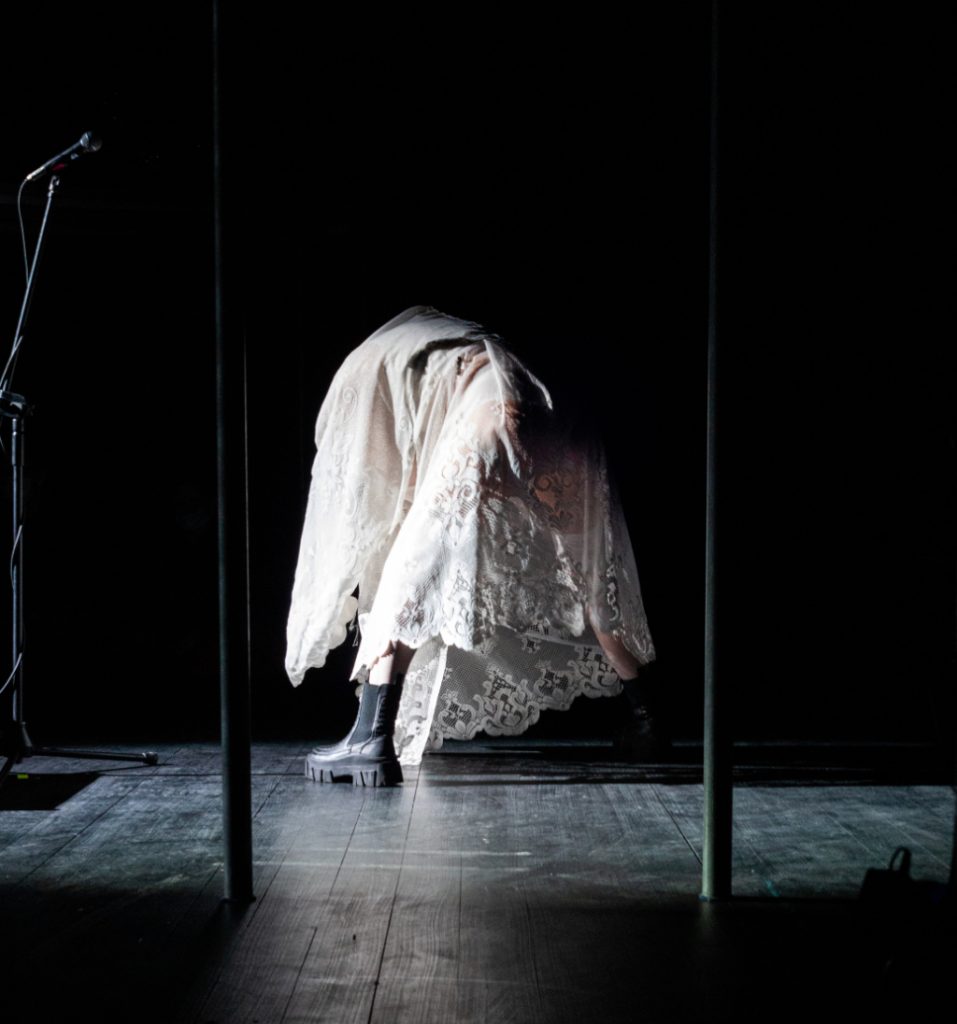Interview Agata Kik

Born in Poland, Zosia Hołubowska is a sound artist and a non-binary activist based in Vienna; wherein 2014, they founded Sounds Queer?, a collective synth lab and a library combining electronic music, sound art and queer activism. The idea behind their work is that music can create a safer place for expression and experience exchange. Starting from a synthesiser as a feminist tool to confront music and social norms, Sounds Queer? Organise, facilitate and run workshops on electronic and synthesiser music.
Apart from activist work Sounds Queer? in Vienna, Zosia Hołubowska is still active in their native land. They are a member of the team of Oramics, the platform founded in 2017 in Poland that collectively curates club nights and concerts, co-curates festivals and other events, organise workshops and run a podcast series online. Together they support female, non-binary and queer artists from Eastern and Central Europe, striving towards solidarity in the international electronic music scene.
As a PhD researcher at the Academy of Fine Arts in Vienna, Zosia Hołubowska explores experimental methodologies in sound art, revisiting archives of traditional music of Eastern Europe. They are fascinated by new technologies and, at the same time, interested in the past, which they queer to create ‘narratives that distort the linearity of time’. They also appear under the name of Mala Herba, an alter-ego of a persona born out of an eclectic electronic music project that sources ideas from the 80s music world and Eastern Europe’s folklore culture.
Mala Herba is an alternate stage persona with which Zosia presents what they could not see represented back then on the music scene of their earliest interests. Mala Herba is a combination of the fragile and the aggressive, a mixing of synthetic sounds with screaming voices, the interweaving of exorcistic laments and dark beats.
The project enacts a purgative release of what has been deeply repressed over the many thousands of years of dark human history. The project comprises heterogeneous sonic overlayers of different moments in time and space, while it combines traditional instruments and singing with rhythmic electronic synthesiser scratches. Mala Herba sounds like a mystical ritual; it feels like healing by the wicked and looks like Boschesque monstrousness ever enacted anew in front of the participating audience.
For the Unsound 2020’s online edition, Zosia Hołubowska was commissioned with artist Julia Giertz to create Community of Grieving, an online audio ritual to submit into suspension of the pandemic’s outbreak collectively.
The artists have also described the work as a sonic ceremony of coming to terms with the state of being isolated, embracing the experience of loss and grief. The piece combined elements of vesper and lament, sonic meditation and narration and constituted an act of collective listening by virtually connected human beings.
A year later, the work was staged in real life at Łaźnia Nowa Theatre during Unsound 2021’s festival edition, the occasion when this previously purely aural piece took on the form of a live performance involving electronic music vocals, choreography and set design. Rather than a spiritual exploration, the work enlivened the ideas of sharing and care enacted by the artists, who held the space for the audience with their physical presence.



In 2020 you were commissioned by Unsound to co-create an online piece, Community of Grieving. One year later, this collaborative work was translated back into the physical space of the festival. Could you share some details about the initial idea? What did this transition mean to you and the work? What were the developments?
There’s a lot to unpack here. The initial idea was to create a space to experience grief over what we have lost in the pandemic times together, although we all felt so isolated and alone. It was a radio piece and a choreographic score, drawing from the spiritual context that Julia and I grew up in. I find catholicism toxic and oppressive, like I have no tools to deal with great events in my life, but it’s what I got.
So I lean on traditions of singing, lamenting, and numinous feeling (by Rudolph Otto) when you enter a temple. To translate the piece meant that we had to explore how to hold the audience’s space with our presence physically. We worked with the idea of offering care and sharing rather than providing answers and exhausting ourselves spiritually. I am very grateful to my team. It was the most difficult project I have ever done. And most beautiful.
You have worked with Julia Giertz on Community of Grieving. Where does collaboration figure in your practice? What were the challenges for you during the periods of enforced isolation during the pandemic?
I believe in the power of community and that we are each other’s answers. That’s a part of my healing meditation. The only challenge was that I wanted to be closer to Julia and be able to hug her when things were getting difficult. Other than that, we have such a connection that our collaboration is organic. On a personal note, isolation was very difficult. Most of my chosen family lives in another country, and not being able to see them and share the little, everyday moments was rough to go through.
The work was part of this year’s edition-themed deep authentic. What is your perspective on authenticity in the day of digitalisation of literally everything?
I don’t think that digitalisation is contrary to authenticity. I think it opens a new dimension of interacting and understanding oneself.
Your sound works are based on electronics, while your vocals play such an important part in them. The physical world gets digitalised and simultaneously distorted. What is the methodology behind your artistic process? And what effect do you want to achieve with such mixing and intertwining?
I like to think that I am reimagining the past, queering it, and filtering it through my own body. At the same time, I am fascinated with new technologies, I am an epic nerd. I think I create narratives that distort the linearity of time and find connections between archaic and sci-fi. I believe that so many questions the Western world is trying to answer with modern technologies have already been answered by Indigenous communities. And on a funny/ philosophical note: distortion enriches the signal, especially in the sound domain.
How would you describe Mala Herba? What is the project inspired by?
It’s my witchy stage persona and a dance-oriented music project. It is inspired by 80’s music and sound and traditional songs from Eastern Europe.
In 2014 you founded Sounds Queer?, currently a collective based in Vienna, with an aim ‘to create a safer queer space through music’. Could you share its beginnings and what it has developed into now? Where do you see its future?
It started with me dragging a backpack of my gear around and setting up workshops on how to start creating electronic music. Now it’s four artists collective: Adele Knall, Tony Renaissance, and Violeza Martinez. We are running a mobile library so people can rent the gear we have collected from donations and funding for why we are looking for a more permanent space. I hope we will find a home and be able to offer an accessible studio, residencies, and workshops again!
From an activist point of view, what do you see in electronic music that is different and that can potentially create higher levels of inclusion and diversity in contemporary culture?
Electronic music’s history was created by fearless femme and gender-nonconforming pioneers that were challenging the theory of music and gender norms. I read that the synthesiser is a feminist instrument, and I agree with Abi Bliss1.
You are part of Oramics, a platform to support women, non-binary and queer people in the electronic music scene. How different is your experience working with this collective in Poland when compared to your activist work in Vienna, in Austria? What is your vision of the future inclusivity of the electronic music scene?
I still feel very emotionally connected to Poland. I think our electronic music scene is growing and becoming more and more fascinating and diverse. It is amazing to be a part of this, although a bit from a distance, and practice the change we want to see happen. I hope the future will be even more exciting and colourful than I can imagine.
What is the chief enemy of creativity?
Exhaustion, precarity, and censorship.
You couldn’t live without…
Singing.






